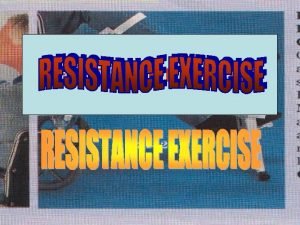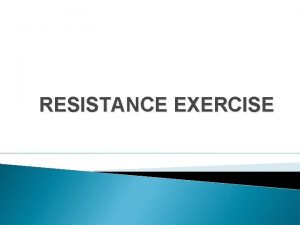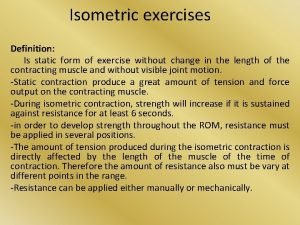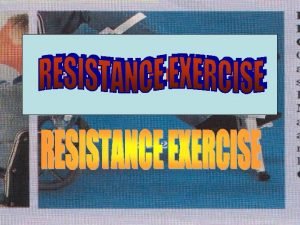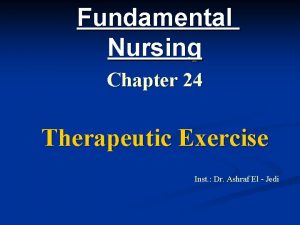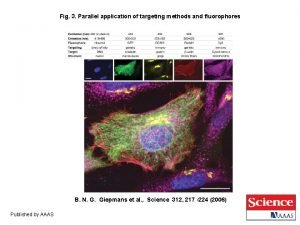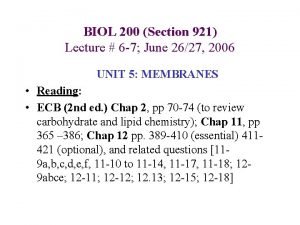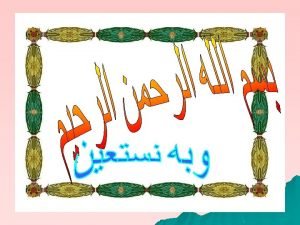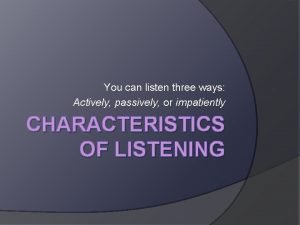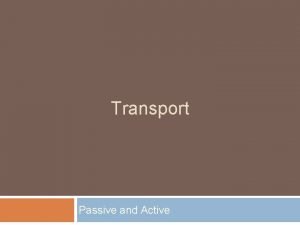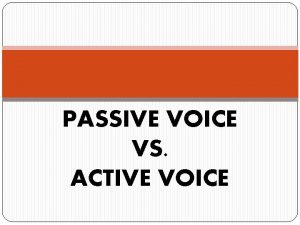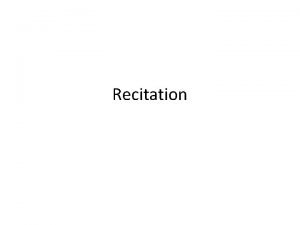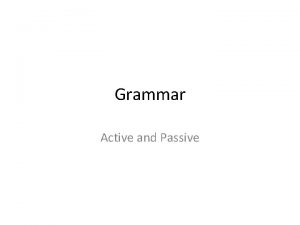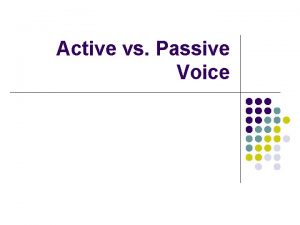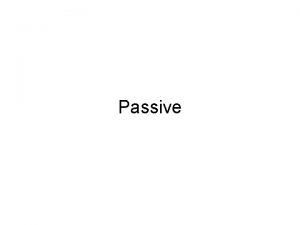Active vs Passive Recovery Recovery after exercise is
























- Slides: 24

Active vs. Passive Recovery • Recovery after exercise is associated with reduction of blood lactate concentration • Active recovery (low intensity aerobic exercise) reduces recovery time compared to passive recovery • During active recovery, blood flow to the active muscles remains high • Since the energy consumption during active recovery remains high, the use of lactate as an energy source is higher compared to passive recovery

Active vs. Passive Recovery • Recovery after exercise is associated with reduction of blood lactate concentration • Active recovery (low intensity aerobic exercise) reduces recovery time compared to passive recovery • During active recovery, blood flow to the active muscles remains high • Since the energy consumption during active recovery remains high, the use of lactate as an energy source is higher compared to passive recovery

Economy of Movement and Mechanical Efficiency in Exercise • Efficiency- the relation between input and resulting output • The quantity of energy required to perform a particular task in relation to the actual work accomplished • Economy of physical effort

Mechanical / biomechanical efficiency Economy Environmental factors

Mechanical Efficiency Mechanical efficiency (%) = Actual mechanical work accomplished Input of energy kgm = VO 2 = תפוקה השקעה x 100

Mechanical Efficiency Example: - 13, 300 kgm of work were generated during 15 minute ride on a stationary bicycle. - Total oxygen consumption 25 liters. Mechanical efficiency calculation: Energy input: 25 liter of oxygen x 5 kcal = 125 kcal 1 kcal = 426 kgm 125 x 426 = 53, 250 kgm Mechanical efficiency = 13, 300 kgm 53, 250 kgm X 100 = 24. 9 %

Efficiency of the Human Body • The efficiency of human locomotion in walking, running and cycling ranges between 20 -30% • 20 -30% of energy consumption is converted to mechanical work and 70 -80% is converted directly to heat • During rest 97% of energy consumption is converted directly to heat

Muscle Profile

Muscle Fiber Types

Motor Units Number of muscle fibers Types of muscle fibers

Muscle Fiber Types Characteristics of the Three Muscle Fiber Types Fiber Type Slow Twitch (ST) Fast Twitch A (FT-A) Fast Twitch B (FT-B) Contraction time Slow Fast Very fast Size of motor neuron Small Large Very large Resistance to fatigue High Intermediate Low Activity used for Aerobic Long term anaerobic Short term anaerobic Force production Low High Very high Mitochondrial density High Intermediate Low Capillary density High Intermediate Low Oxidative capacity High Intermediate Low Glycolytic capacity Low High Major storage fuel Triglycerides Glycogen CP, Glycogen

Distribution of Muscle Fiber Types • • • Genetic association In none active population 40 - 50% ST Long distance runners 50 -90% ST Short distance runners 30 -55% ST Weight lifters 40 -60% ST Muscle fiber type has only a moderate effect on maximal performance

Can training Change Fiber Type? Training a FT -fibered muscle for endurance will not increase the number of ST fibers, nor will training a STfibered muscle for strength and power increase the number of FT fibers. With the proper training, FT -B fibers can take on some of the endurance characteristics of FT -A fibers and FT -A fibers can take on some of the strength and power qualities of FT-B fibers. However, there is no interconversion of fibers. FT fibers cannot become ST fibers, or vice versa. What an athlete is born with is what he or she must live with.

Economy of Movement and Mechanical Efficiency in Exercise • Efficiency- the relation between input and resulting output • The quantity of energy required to perform a particular task in relation to the actual work accomplished • Economy of physical effort

Mechanical / biomechanical efficiency Economy Environmental factors

Mechanical Efficiency Mechanical efficiency (%) = Actual mechanical work accomplished Input of energy kgm = VO 2 = תפוקה השקעה x 100

Mechanical Efficiency Example: - 13, 300 kgm of work were generated during 15 minute ride on a stationary bicycle. - Total oxygen consumption 25 liters. Mechanical efficiency calculation: Energy input: 25 liter of oxygen x 5 kcal = 125 kcal 1 kcal = 426 kgm 125 x 426 = 53, 250 kgm Mechanical efficiency = 13, 300 kgm 53, 250 kgm X 100 = 24. 9 %

Efficiency of the Human Body • The efficiency of human locomotion in walking, running and cycling ranges between 20 -30% • 20 -30% of energy consumption is converted to mechanical work and 70 -80% is converted directly to heat • During rest 97% of energy consumption is converted directly to heat

Muscle Profile

Muscle Fiber Types

Motor Units Number of muscle fibers Types of muscle fibers

Muscle Fiber Types Characteristics of the Three Muscle Fiber Types Fiber Type Slow Twitch (ST) Fast Twitch A (FT-A) Fast Twitch B (FT-B) Contraction time Slow Fast Very fast Size of motor neuron Small Large Very large Resistance to fatigue High Intermediate Low Activity used for Aerobic Long term anaerobic Short term anaerobic Force production Low High Very high Mitochondrial density High Intermediate Low Capillary density High Intermediate Low Oxidative capacity High Intermediate Low Glycolytic capacity Low High Major storage fuel Triglycerides Glycogen CP, Glycogen

Distribution of Muscle Fiber Types • • • Genetic association In none active population 40 - 50% ST Long distance runners 50 -90% ST Short distance runners 30 -55% ST Weight lifters 40 -60% ST Muscle fiber type has only a moderate effect on maximal performance

Can training Change Fiber Type? Training a FT -fibered muscle for endurance will not increase the number of ST fibers, nor will training a STfibered muscle for strength and power increase the number of FT fibers. With the proper training, FT -B fibers can take on some of the endurance characteristics of FT -A fibers and FT -A fibers can take on some of the strength and power qualities of FT-B fibers. However, there is no interconversion of fibers. FT fibers cannot become ST fibers, or vice versa. What an athlete is born with is what he or she must live with.
 Difference between active and passive exercise
Difference between active and passive exercise After me after me after me
After me after me after me If any man desires to come after me
If any man desires to come after me Vttx
Vttx Valvasia
Valvasia Isokinetic exercise definition
Isokinetic exercise definition Active exercise definition
Active exercise definition Active shooter tabletop exercise
Active shooter tabletop exercise Definition of active exercise
Definition of active exercise Active assistive
Active assistive Brief resisted isometric exercise definition
Brief resisted isometric exercise definition Active shooter tabletop exercise
Active shooter tabletop exercise Mechanical resistance exercise
Mechanical resistance exercise Active exercise
Active exercise Powder board exercises
Powder board exercises Active directory disaster recovery best practices
Active directory disaster recovery best practices Fluorescence recovery after photobleaching
Fluorescence recovery after photobleaching Fluorescence recovery after photobleaching
Fluorescence recovery after photobleaching Early recovery after surgery
Early recovery after surgery Range of motion exercises
Range of motion exercises Active high and active low
Active high and active low Primary active transport and secondary active transport
Primary active transport and secondary active transport Primary active transport vs secondary active transport
Primary active transport vs secondary active transport Deliberative listening definition
Deliberative listening definition Louise made the chocolate cake active or passive
Louise made the chocolate cake active or passive




